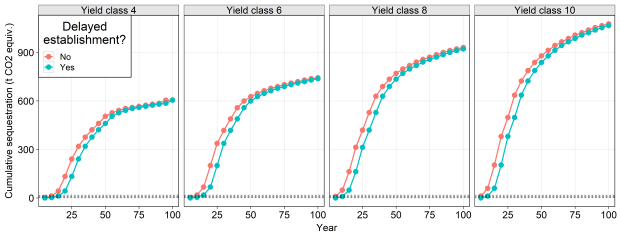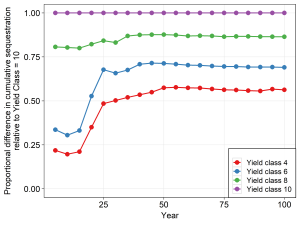A few things I’ve read recently have got me thinking about the benefits of different methods of woodland creation. In particular, I’m interested in how hands-on planting stacks up against hands-off natural regeneration.
Active planting has faced some criticism recently – do we really need all this soil disturbance, wooden stakes, plastic tubes, etc? Can’t we just leave nature to it? One frequent argument in favour of planting is that it results in faster carbon sequestration (foresters are good at maximising growth, after all), which is important given the urgency of the battle against climate breakdown.
I did some searching for studies which compared the rate of carbon sequestration under natural regeneration vs. planting, but found precisely nothing (maybe I used the wrong search terms – please let me know if you’ve had any more luck). What I did manage to find was the Forestry Commission’s Woodland Carbon Code calculator, which briefly (and vaguely) alludes to natural regeneration, stating that “trees are likely to take longer to establish” so we should assume a “conservative [growth] scenario” and “set-back growth by 5 years”.
So, to get a handle on the approximate magnitude of differences between planting and natural regeneration (and how these differences change over time), I used the calculator to plot carbon sequestration under some different scenarios (ignoring differences relating to biodiversity, aesthetics, water, etc.).
The examples below assume that woodland creation occurs on pasture on mineral soil in England. The carbon accumulation curves are for ‘Sycamore-Ash-Birch‘, which is representative of a whole load of native broadleaves (alders, willows, ‘thorns, etc.).
The curves below show the S-shaped increase in cumulative sequestration over time, which starts to slow down after 50 years. The different panels represent different yield classes (on which more below), with higher yield classes delivering more sequestration. The blue curve shows the effect of delaying establishment by 5 years (representing the presumed set-back associated with natural regeneration).

Fig 1
The graph below shows the relative effect of this set-back over time. The cumulative sequestration under ‘delayed planting’ approaches that of ‘immediate planting’ after 50 years. So, if we want to maximise carbon sequestration in the near term, then the 5-year delay associated with natural regeneration is a bit of an issue; over a longer time horizon, it becomes less important.

Fig 2
What about yield class? The WCC seems to suggest we should assume a lower yield class for natural regeneration compared to planting, but I’m not sure why, or how much lower. The graph below shows the cumulative sequestration of yield classes 4, 6, and 8 relative to yield class 10. Comparing the purple (top) and red (bottom) lines shows that a shift from yield class 10 to 4 results in a >40% reduction in cumulative sequestration after 50 years.

Fig 3
So, choosing the right yield scenario really matters to our conclusions. Its effect is much greater than that of a 5-year set-back.
Conclusion: after all this, I’m none the wiser about the relative carbon benefits of active planting vs natural regeneration. Why can’t I find any studies on this?!